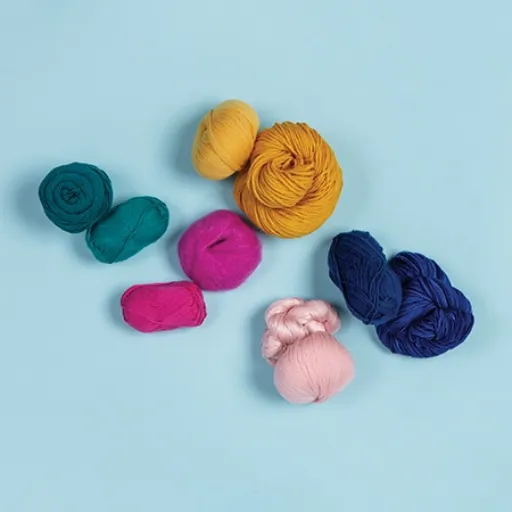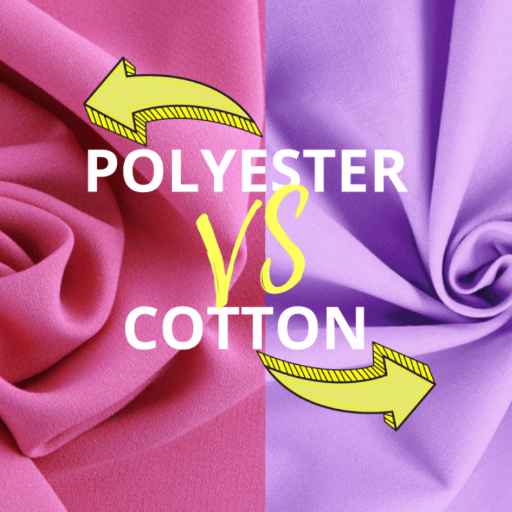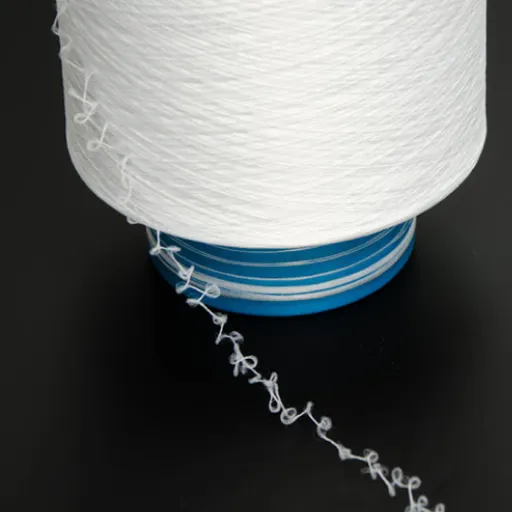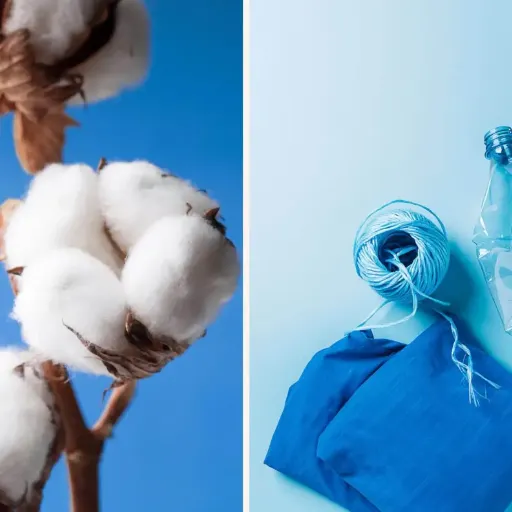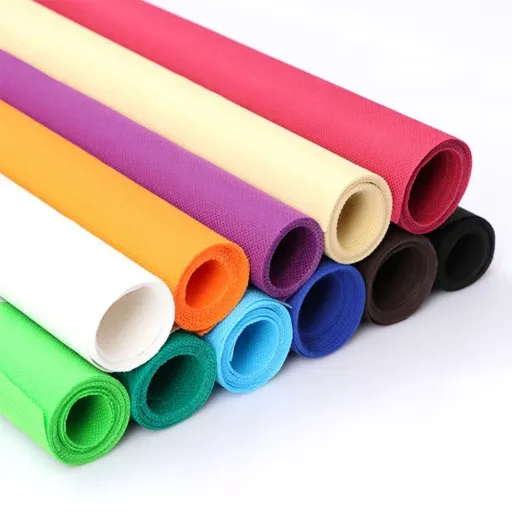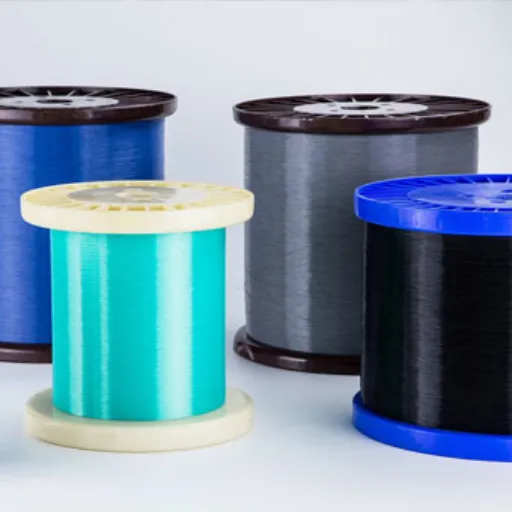The polyester-cotton debate is usually brought into discussion when it comes to choosing the right fabric for clothing, upholstery, or any other textile purpose. Both materials have their own characteristics, hence suitable for different uses and purposes. So, how will you decide what suits you best? This article explores the major differences between polyester and cotton, breaking down the specifics of their durability, comfort, impact on the environment, and so forth. By the end of it all, you will have a clear idea of the pros and cons of either fabric and will be able to make a more informed decision when making your next purchase or considering a new project.
Understanding the Differences Between Cotton and Polyester
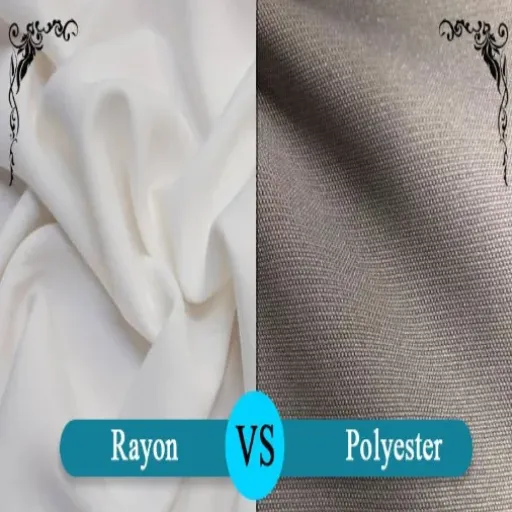
Origins and Manufacturing Processes
Cotton – Natural Fiber
Cotton is a natural fiber that comes from the seeds of the cotton plant. The harvested cotton is then processed by various means-four major steps: ginning to remove the seeds, spinning the fibers into thread, and weaving the thread into fabric. Being a plant-based fiber makes cotton a renewable and biodegradable material, and therefore, cotton draws the attention of an environmentally-conscious population.
Polyester – Synthetic Fiber
Polyester, on the contrary, is a synthetic fiber that goes through chemical processes to be produced. It is derived from petrochemicals such as petroleum, which are converted into polymers and finally into fibers. With such an industrial process and one that consumes non-renewable resources, polyester stands less eco-friendly as compared to cotton.
Manufacturing methods considerably affect these materials’ properties and the environment. Cotton comfort is soft, breathes well, and is suitable for extended wear, while polyester is tough, wrinkle-resistant, and able to dry quickly. Understanding these origins perhaps specifies why cotton is traditionally associated with natural comfort and polyester with practicality and performance.
Key Properties Comparison
Key Properties of Cotton Fabric
- Comfort & Breathability: Cotton fabric is famous for being soft and comfortable, thus allowing it to be used in clothing of almost every kind. Geared for protection, cotton fiber science works in air circulation, thus assisting with maintaining body temperature and preventing the wearer from feeling hot.
- Moisture Absorption: It is very absorbent and can hold in water up to 25 times its weight, thereby giving it excellent moisture-wicking attributes.
- Hypoallergenic Properties: Being cotton is hypoallergenic has another advantage, which makes it more suitable for those with sensitive skin or allergies.
- Durability & Challenges: Cotton holds up better to repeated washes and wear over the course of time, and one of its minor negatives, perhaps, is that it is prone to wrinkling more so than synthetic fabrics.
Cotton fabrics can serve lots of different ends-hours of weight and accompanying textures that go from a pretty light-weight fabric for summer shirts to heavy-weight materials like canvas, and denim. Cotton is famous to shrink, especially if it has not been treated before use; hence most modern manufacturing processes will employ measures to reduce the shrinkage as much as possible. Yet, comfortable, breathable, and versatile are the three qualities guaranteeing that cotton will always be a favorite in textiles.
Key Properties of Polyester Fabric
- Strength & Shape Retention: Polyester is a synthetic fiber known for its strength and versatility. One of its distinguishing features is that it does not stretch or shrink and, therefore, stands as a choice for anything that needs fine treatment.
- Wrinkle Resistance: Polyester is also a fairly wrinkle-resistant fabric. This means that clothes and other fabrics will maintain their shape and finish even after prolonged use or washing.
- Quick Drying: Quicker drying times are another bonus for polyester. Because the fabric is hydrophobic, it does not retain water; hence, it will dry quicker than natural fibers such as cotton.
- Durability: The polyester fabric is also highly durable and withstands wear and tear, such as abrasion and mildew, along with the aggressive effects of sunshine and rain.
Hence, this fabric would be suited for activewear, outdoor equipment, and anything else that is washed often. Additionally, polyester acts well when blended with other fabrics, keeping the wearer comfortable during exercising by drawing sweat away from the skin. Polyester fabrics are lightweight, yet sturdy and strong, and hence, from the strength point of view, end up having a long life and hence they find huge acceptance in fashion, upholstery, and industrial applications.
Durability and Maintenance of Fabrics

Longevity of Cotton vs Polyester
| Aspect | Cotton | Polyester |
|---|---|---|
| Shrinkage | Prone to shrinkage | Resists shrinkage |
| Wrinkling | Wrinkles easily | Wrinkle-resistant |
| Sun/Moisture Damage | More susceptible | More resistant |
| Overall Longevity | Shorter lifespan | Longer lasting |
Unlike cotton and polyester, both have certain properties affecting their longevity. Cotton is some natural fiber that is soft, airy, and comfortable. However, cotton wears out faster than synthetics like polyester because it may shrink, wrinkle, and gets damaged by being exposed to moisture or sunlight for long hours. In the long run, cotton wears off faster, especially if felt through frequent washing or rough usage.
Polyester, however, was created for durability. It resists shrinkage, stretch, and wrinkling, preventing it from losing its shape and structure for a longer time. And being synthetic, it would be less prone to degradation in harsh conditions, like strong sunlight or moisture, than cotton would. Furthermore, the fiber type still offers greater abrasion and tear resistance than cotton, in the long run, especially in tougher environments or applications.
Care and Maintenance Tips
Cotton Care
- Wash with cold or warm water
- Use mild detergents
- Don’t overload the washer
- Air dry when possible
- Use low heat for machine drying
Polyester Care
- Wash with warm water
- Use low to medium heat for drying
- Avoid high heat settings
- Skip fabric softener
- Store in cool, dry places
With good care and maintenance, one can easily lengthen the life span of cotton and polyester fabrics. It is equally important to properly store your garments, no matter which material you have. Clothes need to be stored in cool and dry spots away from direct rays of the sun so as to prevent any discoloration or deterioration. These simple care methods will go a long way in keeping your cotton and polyester fabrics well in shape for years to come.
Common Wear and Tear Issues
⚠️ Common Issues to Watch For:
- Pilling: Both cotton and polyester fabrics have their pilling issues. Pilling occurs when fibers break and form those little balls of fluff that look ugly on the fabric’s surface, especially in areas subject to friction like the underarm or wherever a bag strap rubs against the item.
- Fading: Another common issue for cotton fabric is dulling or fading, especially for darker colors. Exposure to sunlight through washing will, over time, cause dyes to break down and the fabric to lose its vibrancy.
- Shape Loss: Stretching or loss of shape is another issue often encountered with these materials, more so with cotton. Over time, through poor storage or just wearing, something can go awry with the garment being pre-shaped.
To minimize pilling, wash the garment inside out on a gentle cycle, avoiding the tendency to overload the machine. Air drying will also reduce friction, which contributes to the problem. To prevent fading, colored garments should be washed in cold water, turned inside out, and kept away from direct sunlight when stored. To prevent shape loss, heavy cotton items can be hung for long periods, as they will stretch under their own weight. Instead, fold them nicely and put them on a flat surface. Following the right wash and dry settings can also keep the fabric in good shape.
Common Uses of Cotton and Polyester Fabrics
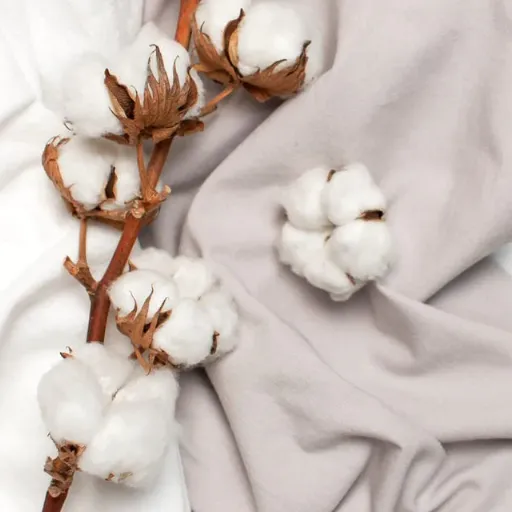
Applications in Activewear
Cotton and polyester are two fabric types mostly applied in activewear, each having certain advantages for specific work-outs. Polyester plies with popularity due to its wear-resistance, lightweight, and moisture-wicking properties. It pulls away the perspiration from the skin, thus being ideal for high-intensity or long-duration training sessions where staying dry is paramount. Moreover, polyester does not shrink or wrinkle; hence garments made from it hold shape even with constant use.
💡 Pro Tip: Fabric Blends
With these contrasting properties of cotton versus polyester, modern activewear combines the two. These blends also allow for a mixture of performance attributes, comfort, and durability to cater to various activities. For instance, fabrics produced from these blends may retain the soft feel and breathability of cotton while offering polyester’s abilities to wick moisture and resist wear.
Cotton, alternatively, is soft, breathable, and comfortable. Thus, for less intense activities on casual days, it is the favorite. Being hypoallergenic and a little more sensitive to your skin than polyester, cotton material benefits people with sensitivities. During extreme exercises, conversely, its water absorption makes cotton less desirable: it is a stronger fabric once it absorbs sweat, takes much more time to dry, and does not cling well to the body.
Suitability for Bedding and Home Textiles
Cotton-polyester blends are perfect for bedding and home textiles by virtue of their near-perfect balance of comfort, durability, and application. Cotton offers a smooth and breathable surface suitable for bedsheets, pillowcases, and duvet covers; polyester contributes strength and durability so that fabrics retain shape and do not lose it due to repetitive washing and wear. Such blends are especially beneficial in bedding, inasmuch as they are easier to care for than pure cotton.
Polyester and cotton blend-bed linens tend to be a bit easier to maintain. Washable with humidity-wicking properties, they do the wonders for a hassle-free setup since polyester steals away the chances of wrinkle buildup that downsize pure cotton bed linens. This means bedding in the cotton-polyester blend prints ever so slightly requires less ironing; in fact, it even retains a crisper look from near to long, thus holding against the desires of those consumers looking for easy-care products for their homes.
These blended fabrics offer various finishes and thread-counts to cater to individual preferences in texture and warmth. They adapt well to different climates and provide insulation during cooler months while allowing breathability in warmer days. Hence, cotton-polyester blends have become an accepted comfort-convenience finish for home textiles.
Casual Clothing Considerations
Comfort, durability, and ease of maintenance are all attributes that should be taken into account for fabric selection in casual clothing. Commonly used in casual wear, cotton-polyester blends infuse the softness of cotton with the strength of polyester and its wrinkle-resistant properties. These blends are perfect for everyday wear because they do not lose the shape quickly and need almost no ironing, which makes them quite convenient.
Another factor to be considered is the breathability-for climactic variability factor. Since cotton is a natural fiber, it allows air circulation and keeps you cool in warm temperatures. Blended fabrics are great in this aspect as they enhance moisture-wicking with polyester, keeping the wearer dry during rigorous physical activities and sudden weather changes. This perfect balance of comfort and performance is what makes these fabrics so popular.
Casual wear has to hold up to times of wear and washing without losing style. Including properties like less shrinkage and fading than pure cotton, cotton-polyester curtails all weathering, thus making it a quality fabric selection. Its diversity and easy upkeep have always been favoring casual wardrobes for every lifestyle.
Environmental Impact: Cotton vs Polyester
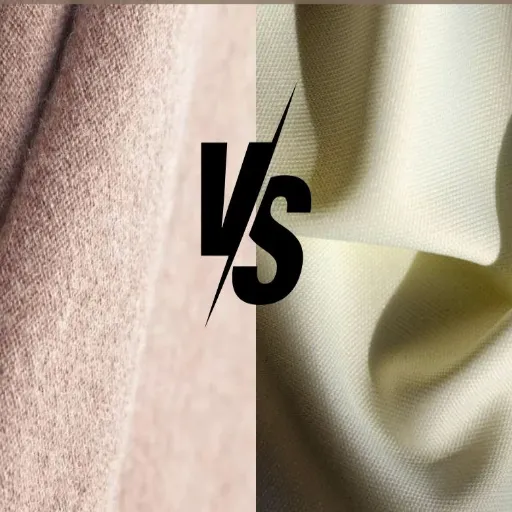
Sustaining Organic Cotton
🌱 Benefits of Organic Cotton:
- Avoids synthetic pesticides and herbicides
- Prevents pollution of soil and water resources
- Maintains biodiversity and ecosystem health
- Uses less water in some areas due to better soil health
- Smaller carbon footprint compared to conventional cotton
Organic cotton is known as the more sustainable alternative to conventional cotton, with much focus on the cultivation. But while conventional cotton uses synthetic pesticides, herbicides, and GM seeds, the production of organic cotton avoids them; thus, preventing pollution of soil, water resources, and the adjoining ecosystems while ensuring biodiversity. Organic farming methods actually use less water in some areas because they maintain good soil health and therefore water retention.
Next, albeit very few carbon footprints can be attached to the cotton type, organic cotton definitely has a smaller carbon footprint. The general avoidance of energy-intensive synthetic chemicals in organic farming greatly lessens the contribution to greenhouse gas emissions. Moreover, activities such as composting and other organic agricultural cultures that contribute to the sequestration of atmospheric carbon are considered beneficial to the environment and in line with the global effort of combating climate change and promoting sustainable agriculture.
Organic cotton production still has to deal with challenges, however, usually having less yield than the conventional cotton. This, in some situations, may become detrimental to the overall sustainability of growing cotton through the need for even more land to grow the same amount of cotton. Yet, with the importance of organic cotton in reducing poisonings from chemicals, sustaining an ecological rhythm, and giving precedence to fair farming, this stands out as the number one choice for consumers and industries that are pursuing sustainable textile solutions.
Biodegradability and Carbon Footprint
| Environmental Factor | Organic Cotton | Polyester |
|---|---|---|
| Biodegradability | ✅ Naturally biodegradable | ❌ 150-200 years to degrade |
| Raw Materials | ✅ Renewable plant-based | ❌ Petroleum-based |
| Carbon Footprint | ✅ Lower emissions | ❌ Higher emissions |
| Recyclability | ⚠️ Limited recycling | ✅ Can be recycled |
When it comes to defining the environmental implications of organic cotton, biodegradability and carbon footprint are indeed very important factors. Organic cotton is naturally biodegradable; it is capable of breaking down without releasing any toxic residues into the environment. When discarded in the appropriate manner, it does deteriorate and help the soil by giving back certain nutrients so as to maintain ecological equilibrium. Hence, it is an environmentally friendlier option as compared to synthetic fibers, which might take hundreds of years to degrade and emit microplastics which are usually toxic.
Carbon footprint of an organic cotton is relatively less as compared to that of conventional cotton mainly because organic farming is not using synthetic fertilizers or synthetic pesticides which required energy-intensive processes to produce. Rather, these organic usages involve several natural farming concepts like crop rotations, and composting to maintain soil health and fertility. To reduce carbon footprint, water less might also be used, or resistant chemicals might not find entry into treatment processes.
Recycling and Eco-Friendly Options
If we’re thinking about the processing of cotton and polyester from recycling and eco-friendly points of view, we need to measure impairment to the environment through their life span. Nylon or polyester, in contrast to cotton as a natural fiber, is technically not biodegradable in the first place. In fact, it might take anywhere from 150 to 200 years for one such nylon-based fabric to degrade fully in the environment. The cotton, in particular, is environmentally friendly to a degree, and its processing sometimes uses a massive amount of water and pesticides. Organic cotton, on the other hand, fights this problem by minimizing the use of chemicals and adopting sustainable farming practices.
Polyester is a synthetic product that has given upstream solutions to the textile industries. Despite this, its manufacture depends on fossil fuel and releases large quantities of greenhouse gases, thus putting it miles further from being considered eco-friendly relative to natural equivalents. Recycled polyester may carry an enormous reduction in environmental footprints by the avoidance of the virgin plastic to a large extent and therefore there are mechanical and chemical processes through which any polyester can be recycled. If not properly recycled, polyester can stay in nature for hundreds of years until its gradual decomposition.
🌍 Making Sustainable Choices:
Try to think about the context in which the material is being used and disposed of when selecting the environmentally friendly option. For higher durability requirements, recycled polyester would be an excellent option, while organic cotton is very nice for biodegradable, renewable material. So, sustainable means continuing to advocate for recycling and making informed decisions to minimize wastes and compromise between performance and environmental responsibility.
Factors to Consider When Choosing the Right Fabric
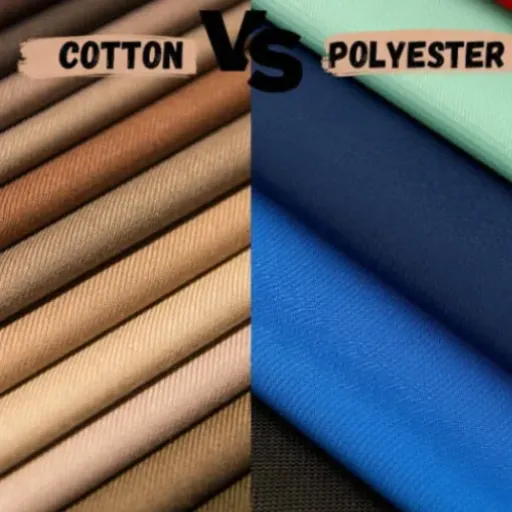
Comfort vs Durability
The cotton-polyester debate dies down with the comfort-versus-durability argument. Cotton has gained popularity for its softness and breathable characteristics, making it mostly suitable for everyday wear-garments comprising t-shirts, bed sheets, and casual attire. Organic cotton is even more environmentally friendly-acclaimed as a sustainable agriculture method. Cotton is prone to faster wear and tear, shrinkage, and wrinkles, especially with repeated washings.
Polyester, conversely, is one of the most durable synthetic fibers, resistant to stretching, shrinking, and wrinkling. It maintains its shape well and makes for an excellent option for activewear, outdoor gear, and anything that needs to withstand daily use. Plus, it dries fairly quickly and wicks away moisture across polyester and fast-drying fabrics; this characteristic is especially useful for activewear.
Not much softer or breathable than cotton, polyester blends, thanks to textile innovations, are now much easier on the skin. Choosing between cotton and polyester will heavily depend on what you intend to use them for. If your priority lays on comfort and breathability, go with cotton. Should the product demand durability, fast drying, and flexibility for active use, polyester will be the right choice.
Choosing Based on Activity Level
Low Activity Level
Choose Cotton For:
- Daily casual wear
- Light exercise (walking)
- Relaxed environments
- Situations where comfort is priority
High Activity Level
Choose Polyester For:
- Sports and gym workouts
- Outdoor adventures
- High-intensity activities
- Performance-focused situations
Depending on activity level, choosing between cotton and polyester means taking into account the mixed demands of the activity with the different qualities of the fabric. Cotton works perfectly in low activity or casual situations. Soft, breathable, and comfortable are some of the attributes it has, which makes daily wear, light exercise such as walking, or hanging out with friends where moisture or sweat and durability is not considered an issue, a good cotton fabric condition.
Polyester performs better for high-intensity activities. Lightweight, moisture-wicking, and quick-drying properties render it suitable for any sort of sport, gym workout, or outdoor adventure. Being a durable and flexible fabric, it can easily withstand repeated movements and tough physical conditions with ease.
Personal Preferences: Cotton or Polyester
🤔 Decision Framework:
Choosing between cotton and polyester largely depends on your personal needs and preferences as well as the specific activities that the fabric in question is going to be utilized for. Both materials possess unique qualities that make one more suitable than the other for given occasions.
Cotton is a natural fiber popular for its softness and breathability. It is ideal in casual wear, low impact activities, and warm circumstances because air can flow freely through it while also absorbing moisture. It is often preferred for comfort reasons, and it is hypoallergenic, making it best for anyone with sensitive skin.
On the other hand, polyester is a synthetic fiber noted for its durability, moisture-wicking ability, and light weight. This material suits the active lifestyle well, as it does not stretch, shrink, or wrinkle; it also dries fast. That would be a plus in any high-performance situations such as work-outs or outdoor sports where moisture management and resilience of the fabrics matter.
The choice thus boils down to whether comfort wins in preference or performance wins in preference. If soft and breathable fabrics are what you would like to put on for some casual wear, then cotton might be considered the best fit. Yet, when you are in need of a fabric tough enough to drag you through active or demanding occasions, polyester fits the bill much better.
Frequently Asked Questions (FAQ)
Q: What’s the difference between cotton and polyester?
A: The major difference between cotton and polyester is that they are made of different materials and possess distinct characteristics. Cotton for example is a natural fiber obtained from the cotton plant, renowned for being soft and attractive. Polyester, however, is a synthetic fiber made from polyethylene terephthalate, which confers upon it the traits of high durability and resistance to wrinkling.
Q: Is cotton or polyester better for sportswear?
A: Cotton clothes are preferred for sportswear that requires more breathability and comfort in some casual way. So polyester sportswear is getting more popular with its fine moisture-wicking properties and durability for going high-intensity. But in the end, whether cotton or polyester is to be chosen for sportswear is a decision made by kings of comfort and must-need performance.
Q: What unique properties does cotton have above polyester fabrics?
A: The cotton fabric is soft, breathable, and naturally absorbent of moisture, thus providing comfort during warm weather. Polyester fabrics, being synthetic materials, are hydrophobic and would repel water while drying quickly. That would be the best choice for wear that has to maintain its shape and withstand the rigors of everyday activities.
Q: Can cotton be blended with polyester and vice versa?
A: Yes! Cotton blends, usually referred to as cotton poly, offer a mixture of natural cotton softness and polyester durability, which results in garments that are able to retain comfort plus the ability to withstand everyday wear. This is why cotton poly blends are highly sought after for casual wear.
Q: What are the advantages of polyester over cotton?
A: Polyester seemed better from many angles: it is more durable due to it resisting shrinkage and stretching, it is smooth to feel, it is less prone to fading, and it rather holds a better resistance to wear and tear than cotton fabrics.
Q: Can polyester be worn all year round?
A: Polyester garments can be worn throughout the seasons; they are, however, really best for cooler weather due to their prizing insulation. They are not as breathable as cotton during summertime, and hence cotton will do better for the warm weather.
Q: What kind of cotton is considered best for apparel?
A: The choice of cotton used in making wear often depends on softness and durability desired. Egyptian cotton is known for its luxury feel, while its counterpart Pima cotton is known for strength and resistance to fraying. Each kind is better than the other in a different way, thus making it necessary to consider the end use.
Q: How about polyester and cotton when it comes to moisture absorption?
A: Cotton absorbs moisture, making it comfortable when the weather is hot. Polyester, on the contrary, is hydrophobic. It shields moisture from the body and rapidly dries. This makes cotton comfortable to wear for casual occasions and polyester ideal for performance.
Q: Why are polyester fabrics so popular?
A: Because they are highly versatile, cheap, and durable, polyester has always been a favorite fabric. It is most often blended with other fabrics such as cotton to enhance performance characteristics while maintaining a soft texture, which is preferred for a wide variety of clothing.
Q: How will I choose between cotton and polyester for my clothing based on fully informed grounds?
A: To make a fully informed choice between cotton and polyester, comfort, use, and maintenance should be considered. Cotton is for casual wear; polyester for activewear and wear where impact resistance is necessary. The two together blend as a compromise, providing half of everything.
References
-
Polyester vs Cotton – what’s the difference? – House of U – A detailed comparison of the properties, benefits, and drawbacks of polyester and cotton.
Polyester Fabric vs Cotton: Differences & 3 Ways to Tell – WellFabric – Insights into the differences between polyester and cotton, including their blends and characteristics.
Cotton VS Polyester: Understanding the Differences – VeeTrends – A comprehensive guide on the sustainability, breathability, and other traits of cotton and polyester.
Cotton vs Polyester: Which Fabric is Right for You? – NW Custom Apparel – A guide to choosing between cotton and polyester based on their features like breathability, durability, and cost.
Cotton VS Polyester: Understanding the Differences – VeeTrends – Another detailed comparison focusing on comfort, maintenance, and use cases for both fabrics.









